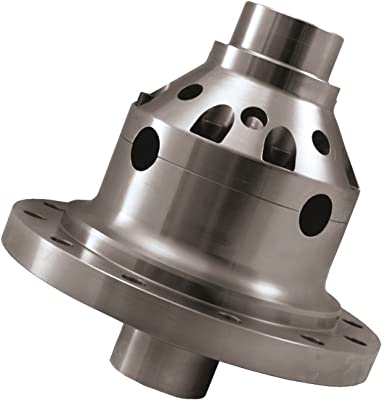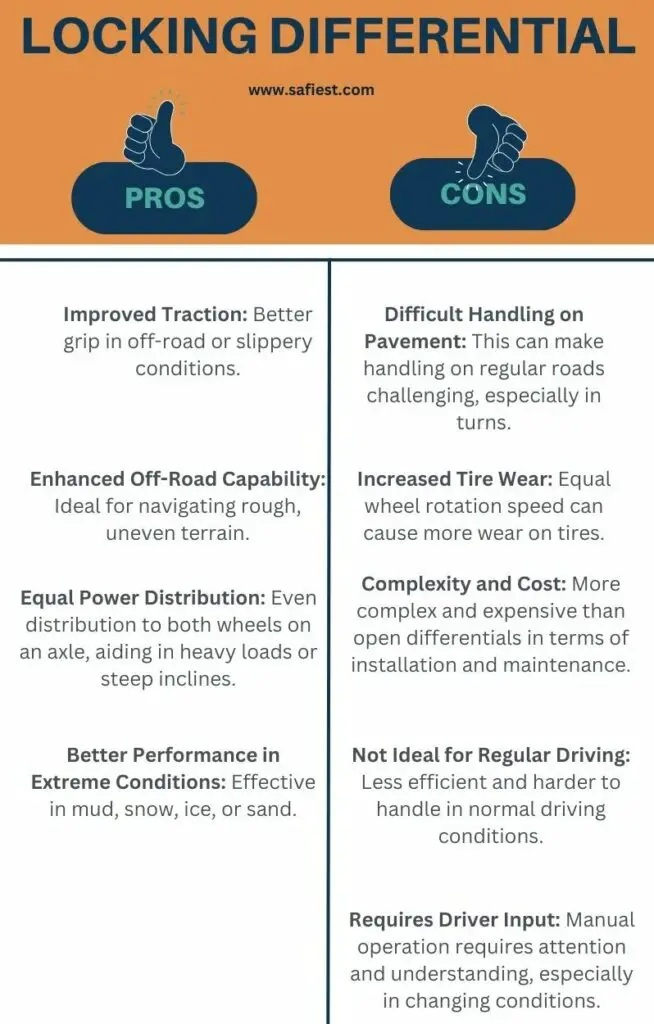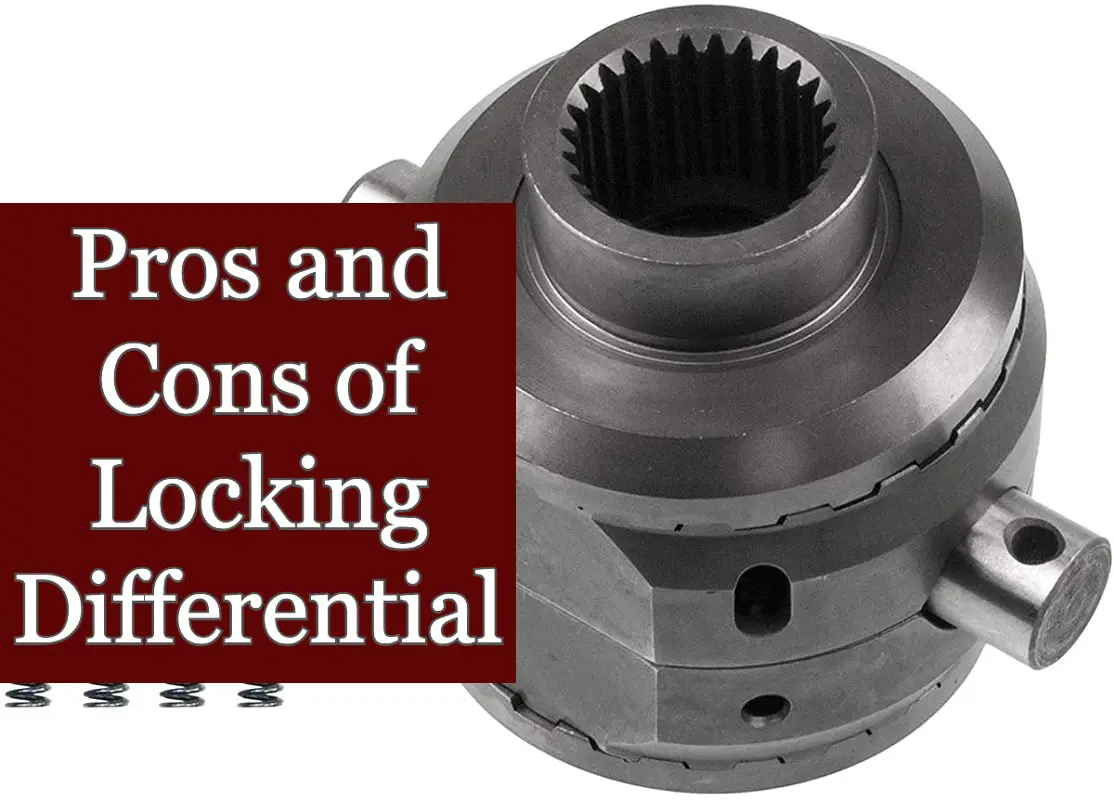If you’re driving on rough terrains and taking all the difficult turns, a locking differential will impel both the wheels to turn, that too with improved traction. While you do get better power, safety, the longevity of tires, and enhanced traction, locking differentials are not budget-responsive.
Among the pros and costs of locking differential, the goods essentially outweigh the bad, and you would need to read on to find out.
What is a locking differential?

Before getting into the particulars about what a locking differential is, let’s give you a recount of what you might already be aware of.
You’ve surely heard of the open differential, a mechanical feature of your vehicle that delivers power to the wheels on the axle. Since both wheels require different amounts of traction while taking a corner, the open differential provides more power to the wheel that receives the least traction, allowing it to turn at different speeds.
A locking differential is also a mechanical locker that comes in use whereas an open differential does not. To put it out simply, a locking differential is a locking feature in your vehicle that bolts two of the wheels together on an axle, with a mission to make them turn at different speeds while doing so.
Whether there is too much traction on one wheel compared to the other, the torque transmission remains the same. This means, with a locking differential, your locked wheels will rotate together.
Locking differentials work using either an automatic method or a driver-selectable method to lock the wheels on access.
Automatic Lockers
As the name suggests, differentials that lock themselves without the need for anyone to control them are automatic lockers.
Since the lockers are called to action only when needed, there’s little chance of depreciating your tires. A lot of people don’t fancy automatic differential locks due to the lack of control they have when using one.
You can find automatic lockers in two forms, Detroit lockers, and lunchbox lockers.
Selectable Lockers
Driver-selectable differential lockers require manual operation and are more expensive than automated ones. These come in both electronic lockers, as well as air or cable ones. These manual lockers may be an effort to repair and a hole in the bank to replace, you would not need to worry about the longevity for eons.
Pros and Cons of Locking Differential

The Benefits of Having a Locking Differential
The benefits of having a locking differential would be best experienced by those who love off-roading. So, for one, a locking differential can improve the performance of your vehicle when you are driving on rocky roads and uneven terrains.
A locking differential’s ability to deliver equal power to both wheels while making them turn all at once is indeed a game changer. That’s because the locking differential does not take into account the traction difference factors, no matter how little.
With that mentioned, you may be aware of how off-roading involves taking your vehicle to grim, snow, and sludge. When driving on these rougher roads, you may have noticed how wheel contact with the surface is not steady.
Now, if one of the wheels loses contact with the ground, there are high chances of vehicle damage. Why so? Without a locking differential, the amount of torque delivered to both wheels will depend on the wheel with lesser traction. Which, if not enough, would result in the failure to move the car forward. This is one of the biggest benefits of having a locking differential your vehicle would not be stuck, come what may.
In addition to experiencing an increase in the speed of the vehicle, locking differentials can also revamp the control and handling of the vehicle. Something particularly important when off-roading.
Other than that, a locking differential helps to improve the longevity of your wheels. The suspension system of any vehicle works to keep the center of the tires grounded, in its quite literal meaning. This contact with the ground is essential to the tire’s long life. Thanks to the locking differentials, this contract, and hence the traction are accounted for.
Locking differential boosts your safety and security. Whether it is automatic or selectable, these lockers do add a veneer of safety on unpredictable roads. The extra feature of being able to keep your car locked when it is about to slide is a great perk.
Other than safety, feasibility and convenience have always been a driver’s mantra, especially in adventure sports. Locking differential wastes no time in being activated as it can be done so using a simple push of a button. Moreover, the installation is easy and versatile with options of installing the differential to be equipped with either or both the front and rear axle.
When you are using locking differentials, you can select selectable lockers for regular driving and automatic for adventure driving, both of which would enable similar pros of using locking differential.
The Drawbacks of Having a Locking Differential
While it may all just seem like an attempt to pay homage to lock differentials to get you to buy one, we are keeping it real.
There are a few disadvantages of having a locking differential that you may want to know about. One of the major drawbacks of locking differential that daunts many from buying it is the price point. Selectable lockers are slightly more expensive than automatic ones but they still need a little bit of investment.
What deters some people from using locking differential despite knowing its benefits is the noisy operations. These lockers tend to make chirping and hash noises, particularly when the car is turning.
Another problem with locking differential is that without the right and proper use, one may unknowingly damage the driveline parts of the car. Additionally, selectable lockers as a differential can be quite tedious to repair and replace.
When to Use a Locking Differential
With the pros and cons of locking differential sorted out, it’s time to know when to use the lockers to make the best use of them. You would only want to use a locking differential when you are off-roading.
When you are off-roading, your vehicle will require you to drive on unconventional roads. This would include muddy, icy, snowy roads. You would also want to use a locking differential on terrains that have rocky paths, sand, gravel, and uneven surface heights.
Knotty and precarious adventure thrillers who love the adrenaline rush of moving in steep plains can also use a locking differential.
When Not to Use a Locking Differential
You should not use a locking differential when you are on your city roads or any other conventional plain highways. You would not need to use these lockers anywhere where there is no need to deliver extra traction. However, driver-selectable lockers allow you to use the differential locker for more regular use.
Final Words
A locking differential is an essential mechanical feature to have in your vehicle when you are driving on rough and unprecedented roads.
On the dot, locking differentials will ensure stable and continuous driving, by compelling both wheels to turn, regardless of traction difference. Keeping the pros and cons of locking differential in mind, you would want to only use the feature when driving on rough roads.
